|
Fitness Blog Covering Topics Of Interest Monday, November 12 2012
The story of a four-year-old boy in India who has been running distances of up to 60 kilometers has led to a lot of discussions, including among the Take The Magic Step® team. We spoke to Dr. Henning Ohlert about appropriate exercise for young children, as well as about some strategies for parents to deal with this issue. Dr. Ohlert, 46, is a lecturer of training science at the University of Potsdam. He was a professional athlete for ten years, and as a 23-year-old ran the 800 meters in 1:45.9. He is working on a long-term study of motor skills and development of ten-year-old children.  © Betty Shepherd How much exercise can a child cope with? Over the years, our attitude towards children’s capabilities has changed tremendously. Basically, you could say that children are “little champions of endurance.” The big advantage of children is that they stop what they are doing automatically when they feel that they are getting tired and reach their physical limits. If children are tired out during playing, they simply take a break, and once they have recovered, they get active again. I think that you cannot do anything wrong with children-you just cannot challenge them physically in the wrong way. They know how to adjust themselves, and will utter their disapproval when it gets too much for them. And this disapproval should be respected. What you have to watch out for with children, however, is problems with their thermoregulation; that is, the loss of body warmth during physical activity. Children get red faces when they are playing, bouncing around or playing sports. The body warmth which develops causes fast panting while breathing. The reason for this is that their perspiration system with does not function as that of an adult yet. That’s why you have to be careful to prevent children from overheating. In general, however, children have quite a sensitive feeling for the right proportion of activity and rest. It is highly dangerous, though, what is demanded of the little boy in India. How can parents tell what and how much they can expect and ask from their children? I believe you can ask more from children than most parents would think. You can judge by certain subjective criteria if a physical activity is enough: the color of the skin (for example, if the paleness of the skin is extreme), the frequency of the breath, the heart rate as well as the quality of movements. You will realize pretty quickly that movements seem to become uncontrolled and the way children fall changes. These are clear indications for the necessity of a break. 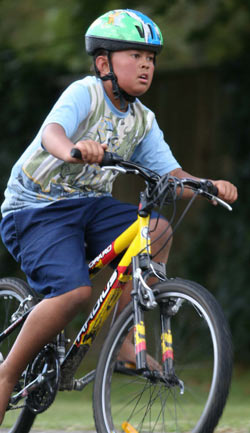 © Betty Shepherd At what age should children start to train on a regular basis? In order to answer this question, you would have to define the term “systemically organized training” first. I think that until a child has reached the age of eight, we shouldn’t call it training. There is nothing wrong with daily exercise or physical activities. Children should be active in various non-specific ways and thereby gain a broad range of experiences. This is the best prerequisite for successful involvement in sports later on. Is there such a thing as unathletic children? In my opinion, there is no such thing as unsporty kids. At times someone gets called “unathletic” just because he is judged by certain skills and abilities. It is just normal, however, that you are not able to do things which you have never done or practiced before. Often you get also judged by your family background. But just because your parents consider themselves unathletic, it does not necessarily have to mean that the son or daughter is as well. Every child is athletic. The question is only if she is athletic enough to become a champion. Don’t children have a natural urge to move? Absolutely. Unfortunately, this urge is lost throughout the ontogenetic development. At puberty, this urge to move decreases. This is when young athletes often lose interest in their sport and don’t show up for training anymore. Should parents try to intervene? It would not be good if the enthusiasm for the sport got completely lost. It is normal and should be tolerated that there are phases of less motivation. You should still try to talk to your child, his or her coach and friends about the situation, options and possible wasted opportunities. Children tend to change their enthusiasm for different things quite quickly. Today they are playing tennis, tomorrow they want to become a professional swimmer, the day after tomorrow a famous basketball player. Sometimes they are not sure at all. Should children do several kinds of sport or should they better concentrate on one? I strongly recommend that children experience a rather broad range of physical activities. I assume that not every child should be trained to become a Davis Cup player. Instead, most children will just want to play tennis for fun, or they just want to go inline skating, running or play soccer. I am a great supporter of children practicing a variety of sports. Is it naive to believe that children will be grateful one day if parents put some pressure on them and force them to keep up a certain sport, hoping that they will be successful and the sport turns out to be the right one for the child? This wish or hope might be honorable, but children think differently. Children think very emotionally, and are not as rational as adults are. The reasons why children give up on something are not easily understood. A little bit of pressure might not be wrong. It is a great achievement, however, if children discover themselves what they like. Should parents tell their children which expectations they have regarding their sporting performance? Parents’ expectations should not put too much negative pressure on the children. There is a lot of evidence in pedagogy that children fail just because their parents were asking too much of them. Children often act paralyzed if they are put under too much pressure. Then they are often criticized for failing mentally, but no one realizes how much pressure has been put on them: “You have to do this, you have to do that!” Parents have to learn to judge their children’s mental condition and figure out how they can teach them ambition and determination. As a matter of fact, a runner participates in a race to get to the finish line among the best and not far behind the first ones. Consequently, you can, of course, tell your children that sport is often about being better and faster than others. This should be done sensibly, however, and without any pressure. It is nearly impossible to get children’s enthusiasm back if you have put them off doing sports once and if sports have become a trauma for them. This is proven by scientific research. The next chance you get to convince them of doing sports again is when they have grown up and when stress at work and an unhealthy diet have caused health problems and the cardiologist tells them, “You have to get moving, you have to exercise!” 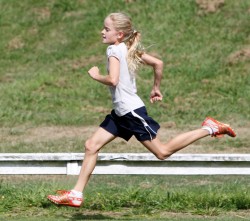 © Betty Shepherd On the other hand, children are often highly motivated when their parents watch them at training or competitions. It is obvious that children are extremely motivated when they realize that their parents fully support what they are doing. At some stage, however, their own motivation will become so high that they don’t need their mother’s or father’s support anymore. But even professional athletes are more motivated when their parents are in the stadium or along the race course, no matter if in tennis, soccer or running. The question is just how parents react to their children’s failure. It is important that you find out together-maybe even with the coach-where mistakes might have been made and how you could adapt the training. Children have to feel that you support them and don’t give up on them. What should parents do if their child suddenly, after two years, does not like judo anymore and would rather want to do athletics or tennis? Should parents demand that their children continue doing what they have started to do and not to give up on something just because it is no fun at the time? I don’t find it too bad to change from one kind of sport to the other. You should have a conversation and clarify why they don’t like the sport they used to do anymore. There are certainly understandable reasons for it. And if they are not understandable, you still should not act against your child’s wish. What should parents do if they recognize sporting talent in their child, but are not sure if they want to support it? If someone thinks his child has got talent in some area which is illustrated by being better at something than other children of the same age, I would recommend approaching a sporting club close by and asking if there are facilities to support this talent specifically. I don’t find it very good to place children in “talent factories” far away from home where they waste a lot of time traveling to and from the place. Children should be able to pursue their training without many hassles. If they further develop and prove their talent, there are more opportunities of support in young adulthood, such as elite sporting schools or scholarships. And vice versa: How are mothers and fathers to act if children desperately want to become professional athletes, but just seem to lack the talent? I would still give the child the same chances, as eventually the “moment of truth” will show if the child is as good as she thinks she is. In cases of constant failure, however, you should be honest with your child, and tell him that another kind of sport might be more suitable for him. There are a lot of children who change to another kind of sport after the advice of a friend or parents and who have become really successful at it. Children who are motivated and ambitious should initially do what they prefer and should try things out. If parents for some reason think that they should apply sanctions against their child-maybe because of bad marks at school-are prohibiting going to training and doing sports reasonable disciplinary measures? I find prohibiting sports as punishment pedagogically not wise. Children have a natural urge to move and to play in order to cope with stress and emotions, and you cannot just switch this behavioral pattern off. If they are aggressive at school, they will be aggressive at sports, too. But particularly here, those negative emotions can be turned around into positive ones-through the pure movement, through the contact with the coach, through the group dynamics in team sports where bonding and camaraderie are crucial. Saturday, July 28 2012
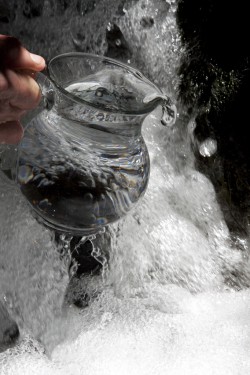 © Betty Shepherd
When you decide on your favorite summer workouts—we discussed a few fun options in Part I—you can move on to organize everything so you stay healthy and well-hydrated during your fitness routine. First of all, add extra care to how you prepare for your workouts. Make sure you are properly hydrated beforehand. Drink small amounts of water frequently, beginning two hours before you go out. I would not necessarily drink too much for 20 to 30 minutes prior to your start, though, because it can make you need to “go” while working out. If you plan to work out for more than one hour, you might want to run with a water bottle belt, as many athletes do. You also could leave one or more water bottles on the course. If you decide on that strategy, it is best to stay on a loop course. This gives you a chance to replenish every few miles. And, if you want to be absolutely safe, ask a friend to join you on a bike. For bikers, use both your water bottles, and stay ahead of the game by stopping at any convenience store or gasoline station to fill-up your bottles before you need them again. Listen to Your Body, Stay HealthyNothing is more important than listening to your body. If you do not feel well, please be very cautious. Before, during, and after your workouts, the first signs of a possible problem might be heavier breathing, an elevated heart rate, or losing concentration. Consider wearing a heart rate monitor—it can caution you before you run into trouble. When you feel unwell, admit it to yourself early on and get out of the heat right away. Cool off with a cold towel, use ice cubes, and hydrate! Please, do not wait to see a physician if you do not feel better immediately. Be familiar with some of the early warning signs of overheating: dizziness, fainting, fatigue, hot skin and followed by chills, lack of perspiration, feeling thirsty, and elevated heart rate. If you stop sweating, you most likely are very dehydrated(1). Also be careful after your workout. Take a dry shirt to put on after your run, and always take some fluid to drink. If you feel cold—even in summer, for example when you come from outside into an air-conditioned room while still wearing your wet workout clothes—change immediately into dry clothes. It may be summer, but you need to stay “warm” after your workouts to avoid weakening your immune system and maybe getting a cold. For adequate protection, sunscreen, glasses, a summer hat, and a rain jacket are always good to have close by. Hydrate Well Throughout the Day © Betty Shepherd It can be very warm and dry during the summer, so make sure you stay cool and hydrated at all times. There are some guidelines I would suggest, and one of my favorite is to keep a bottle of water or a sports drink close by. This will remind you to drink and get replenished with small amounts continuously and evenly spread out throughout the day. Hydration is critical for many body functions, such as digestion, regulation of body temperature, and the circulatory processes that bring nutrients to the cells and transport waste from them. This is even more understandable when considering that our bodies are up to 75% water in total, depending on age and build, with blood being 83% water and the brain being 75 to 78% water. These are the levels when each of those organs work best(2). When you get dehydrated, every cell in your body suffers, causing you to feel less fit and fatigued(3). This puts more stress on your body and makes you more prone to illness and disease. And you can be at risk of overheating, which can have terribly serious consequences—including being life-threatening. For proper hydration, start with juice from a fresh squeezed lemon with lots of water first thing in the morning. It is good for re-hydration after your night’s sleep and also will help your body to detoxify. And as mentioned earlier, drink enough before, if possible during, and right after your training. It is best to replenish within 30 minutes of finishing your workout—the so-called “recovery window.” I like to eat a big slice of water melon right after my training, it is a great source of water, antioxidants, and easily digested carbohydrates. In the following article “General Guidelines,” you can find more information on this topic. A Few Thoughts on Summer Nutrition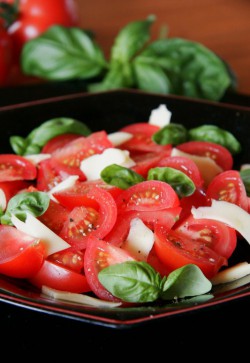 © Betty Shepherd Many people like to adjust their nutrition and take advantage of everything that is fresh and more available in the summer, like tasty fruits and vegetables. It is berry season—maybe you are lucky enough to be able to pick your own on a berry farm. Eat food that has high water content like melon, citrus fruits, berries, and vegetables. Diluted fruit juices with 1 part juice and up to 2 parts water can help you to stay hydrated. The juice from sour cherries, for example, has many health benefits and can even support faster strength recovery for runners. You also can try the many different kinds of unsweetened iced teas. My favorite flavor is mango. Enjoy what you eat and make it tasty. Add some cool summer nutrition like different kinds of smoothies. Depending on the amount you make, they even can be served as an entire meal. Just add water, berries (like raspberries and blueberries), banana, whey protein, and some ice cubes into a blender. Mix it and enjoy. Or try a variation with mango or pineapple. And for more health benefits, add a teaspoon of ground flaxseeds. There also are many delicious salad creations with great dressings. You could try a variety of citrus dressings. Other choices of salads include my favorites—fresh cucumber salad with dill and onions or a tomato salad with olives, feta, and basil. Sashimi and sushi can be delightful lighter dinner fare when well-portioned. And when you prepare your meals, add more vegetables than pasta or potatoes. And how about cold summer soups like water cress and gazpacho? And for all you BBQ lovers, here are some thoughts on “Healthier Grilling.” I hope you can enjoy many relaxing summer evenings with your family and friends. Good luck for your summertime fitness!
Sunday, June 10 2012
 © Betty Shepherd Summer is such a beautiful time of the year. Happy days with stunning sunrises, long, warm evenings and relaxing afternoons freshened up with lemonade and watermelon. Even on hot days, it is not difficult to find great exercises to keep your fitness level up. Summer is also special because you can finally do the workouts you might have been missing during the colder months of the year. You even can take advantage of the training sessions you would not necessarily do during the ideal training period for other sports in winter. You can add cross-training, as well. That means you can work out in other sports or add exercises that support what you normally focus on. It gives you an opportunity to prepare yourself for your upcoming autumn events or improve your fitness and skills for your favorite winter sports. Cross-training can give you a wide variety of workout choices which can enable you to reach your goals. In the summer, you have a wonderful opportunity to take advantage of the outdoors and experience beautiful connections to nature—the oceans, lakes, rivers, beaches, mountains, and shady woods and forests. Before we go on, however, I would advise getting a physical before you start your summertime fitness, making sure you are fit enough to work out in those warm conditions and are able to stay ahead of the game. It is a time that is good for more than just goal setting. You also can talk about your fitness ideas and workout possibilities for the upcoming months and decide if they are realistic for you. Your Favorite Summer WorkoutsOf course, in summer—as well as year-round—do activities you enjoy. They might include your favorite ball game, long hikes, water sports, or anything that is giving you excitement and happiness while exercising. Maybe you have some “wishes” you can turn into goals—like improving your fitness, learning to surf, running your first 5K, hiking a mountain, or biking some new trails by the end of the warmest time of the year. When you follow a path of realistic and achievable short-term goals, it can be much easier to stay motivated and make it fun to reach your goal. 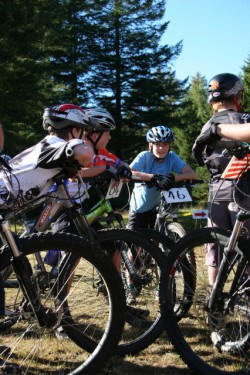 © Betty Shepherd It always is a good idea to include your favorite workouts first, then, integrate new opportunities as the summer progresses. By the end of the warmest months, you will have explored and tried different exercises—alternatives you may have been curious about, perhaps, and had thought could be fun for you. Ball games, swimming, water sports, mountain biking, running, hiking, camping, for example, all are great exercises to try during the summer, especially if you had never done so before or if it had been a long time since you did them. And if you are ready to take on multiple challenges, nothing might be better than combining a number of activities. My favorite summer workouts are those easy and relaxing evening runs, when the sun starts to set and the air is getting fresher, when I can play with those long shadows in the forest. I often combine them with a swim, diving into a lake after my run. Sometimes I jog a few miles to a beach by a lake and cool-off by swimming for some distance, depending on how I feel after my run. I used to do this often as a kid and later during my track season. I have enjoyed it ever since. As the previous comment illustrates, summer workouts are a great way of rekindling happy childhood memories: those long days of carefree summer vacations from school, playing baseball, basketball, or soccer, or maybe completing a track session in the stadium. Perhaps you have a loving memory of the smell of freshly cut grass. That wonderfully distinctive aroma always reminds me of the newly-mown infield at the local track when I was a kid. During the warmest time of the year, it is best to wait for temperatures to have fallen in the early morning or the late evening. Any kind of ball game—basketball, baseball, soccer, or tennis—is fun to play in the cooler evenings. With dusk still far away, you can arrange to get together with your friends after work and add informal versions of these games to your other activities. This can be fun and often makes it easier to stay fit. When I was growing up and started running, we played lots of ball games as warm-ups for our training sessions. A game of team handball or volleyball was just right for us kids. Coming from Germany, soccer always was the favorite. Maybe you can join a group of friends to play a game? You will soon find the countless sprints to get the ball or trying to keep it will definitely give you good cardiovascular exercise. Huffing and puffing, I sometimes had to stop running to catch my breath. For many of us, nothing is nicer than taking part in summer water sports. You can enjoy the whole day at a lake or the ocean with activities such as paddle boarding, kayaking, surfing, snorkeling, or playing different water ball games with your friends. These all are sports that can provide fun activities for you and your entire family. If you don’t have the luxury of a few free days, try a nice swim before or after work, or, if time permits, during your lunch break. Swimming is not only a great cardiovascular workout, and refreshing during the summer months, it also can help you recover from more strenuous training like biking or running. And, at the same time, it will improve deeper breathing. 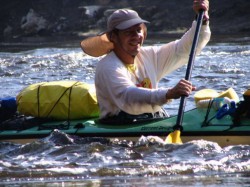 Dave enjoys kayaking across the state of Florida. © Dave Bracknell A former client of mine started with a few sprint triathlons in the summer and quickly moved up to the Olympic distance in winter. He later discovered that kayaking would be fun for him, too. I got an email message from him with breathtaking photos of the ocean and his kayak resting on a beach. He wrote that he just kayaked across the state of Florida in a charity event. I can imagine that he had a fun pool party afterwards! It is a great idea to start a party with your family and friends in late afternoon, playing ball and enjoying swim games, and later taking in the sunset while having a super-tasty barbecue. Could an interesting hike become one of your favorite workouts? Even a leisurely “glow worm and fire flies” hike on a cool summer night might be something you would enjoy. It can be such a fun activity for the whole family. And if you choose a long day hike, you might want to top it off by camping out overnight under the stars. Change the Venue, Adjust Your Goals, and Explore Cross-TrainingSure, you want to avoid the hottest part of the day—so go inside! Join a gym for the warmest months, and instead of running or biking outside, try the treadmill or the stationary bike or one of the many other aerobic exercise machines available at most gyms. You always can exercise outside during the cooler temperatures around sunrise and sunset. The nice thing about summer events is that most of them take place in the morning or evening hours. Nothing is better than completing your workout or event and meeting friends for a late breakfast afterwards. “It’s just a piece of pancake!” Adjust your fitness goals for the warmest time of the year. As always, it is best to set realistic, achievable, short-term goals. I recommend focusing on a few shorter workouts with higher intensity and playful variations in speed. Perhaps your goal might be to become faster in your sport during the summer. Then in autumn, you can add some endurance and focus on longer events again. Once you accomplish your summer goals, you can use your improved fitness to achieve great results in your events later in the year. 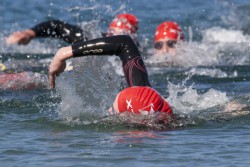 © Betty Shepherd Here are some ideas. If you are a triathlete, you might want to improve one of your disciplines to be better prepared for competition in the fall. To work on your swimming might be a good idea. Or you might change from running to more biking, and in the colder months add longer running workouts again. There are great duathlon competitions in the summer. To work on improving your speed, you may decide to prepare for a sprint triathlon or a sprint duathlon, instead of the longer versions. Many runners may just have finished a spring marathon. The warm summer months are ideal to prepare for a 5K, and in late August one could prepare for a 10K. Then, in September, you can get ready for a half marathon. All the training and goal setting can be done with the ultimate aim of a faster marathon. Or simply enjoy the shorter distances as your main event all summer. That is good, too! You also can switch from one sport to another. Think “off season training.” For runners, bike and swim instead of doing high mileage running. Some bikers go from the road into the forest and mountain bike, it is a great way to improve your skills. Enjoy water sports like kayaking or paddle boarding. Compete in team swimming events, relays are always great fun. A good goal could be to work on other elements of fitness, like strength or technique training, especially if these are areas in which you already want to improve. To do this, you may want to include these new elements in your routine during the summer so you are better prepared for your upcoming events later in the year. I love these elements of cross-training. They can give you a chance to try out a variety of workouts—not doing the same activity every day. And they can be done indoors during the warmest hours of the day. Think about it as something you can look forward to complement your training. Deep-water running, core strengthening, light weights, stretching and yoga… they all can be added to your summertime fitness routine. In this manner, you can condition your body for your fall events—to be a better runner, biker, or golfer—and for your winter sports to be a stronger skier, snowboarder, or skater. Be prepared to adjust your workouts according to the weather conditions on any given day. It can be hot, humid or rainy, and setting a new and easier goal will help you achieve them. Maybe you, too, would love to combine some of your runs with a cooling swim afterwards. And finally, a general suggestion for your summer workouts: start them slowly, increasing your workload in gentle increments. The weather conditions can be challenging and even deceptive. By starting your workouts carefully, keeping your strength in reserve, you will be able to keep your body temperature and your pulse lower. And you will not get so fatigued. In many climates, temperatures can change dramatically over the course of the day, so always be aware of the conditions in which you do your activities and training. Of course, during summer months, adequate hydration should always be on your mind. Fitness Programs and Sport Events You Can JoinCheck out recreational leagues and programs for adults and kids in your area. Your town, local fitness club, and local businesses might offer programs for many sports and events, and maybe you would like to join one of them. This way you also might meet new friends and enjoy staying fit together. It might even not feel like working out hard at all. There are many events over the summer that may be of interest to you. Some of them are charity rides or runs where you also can get the satisfaction of helping your community or a charity that touches your heart like SOS Outreach with which Take The Magic Step is a partner. In “Summertime Fitness: Part II,” I will explore proper hydration and offer a few thoughts on summer nutrition. Until then, I hope you can enjoy your fun and cool summertime fitness!
|
 |



